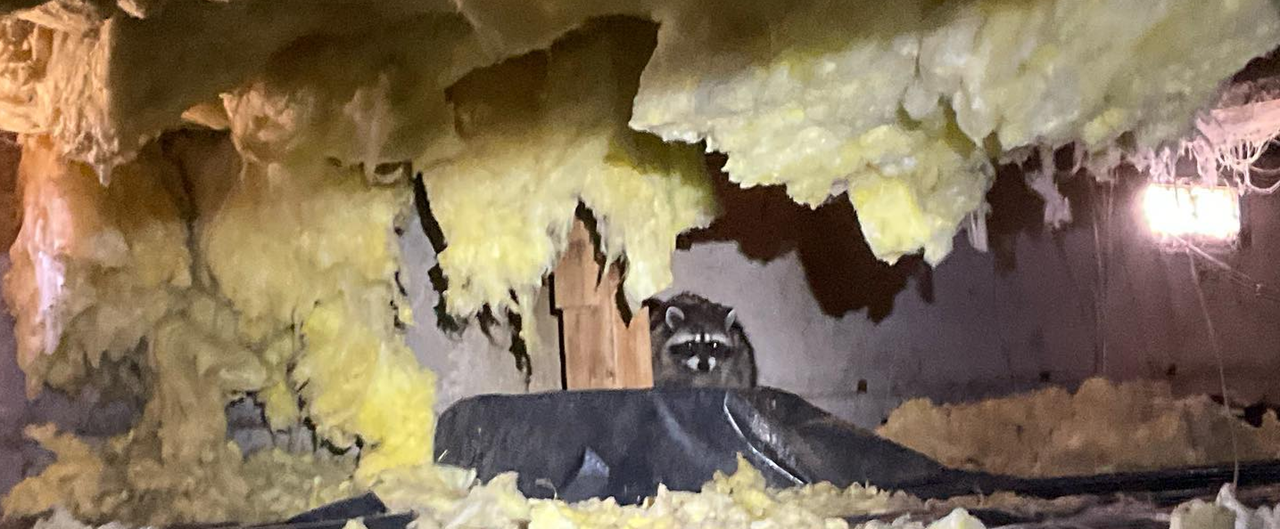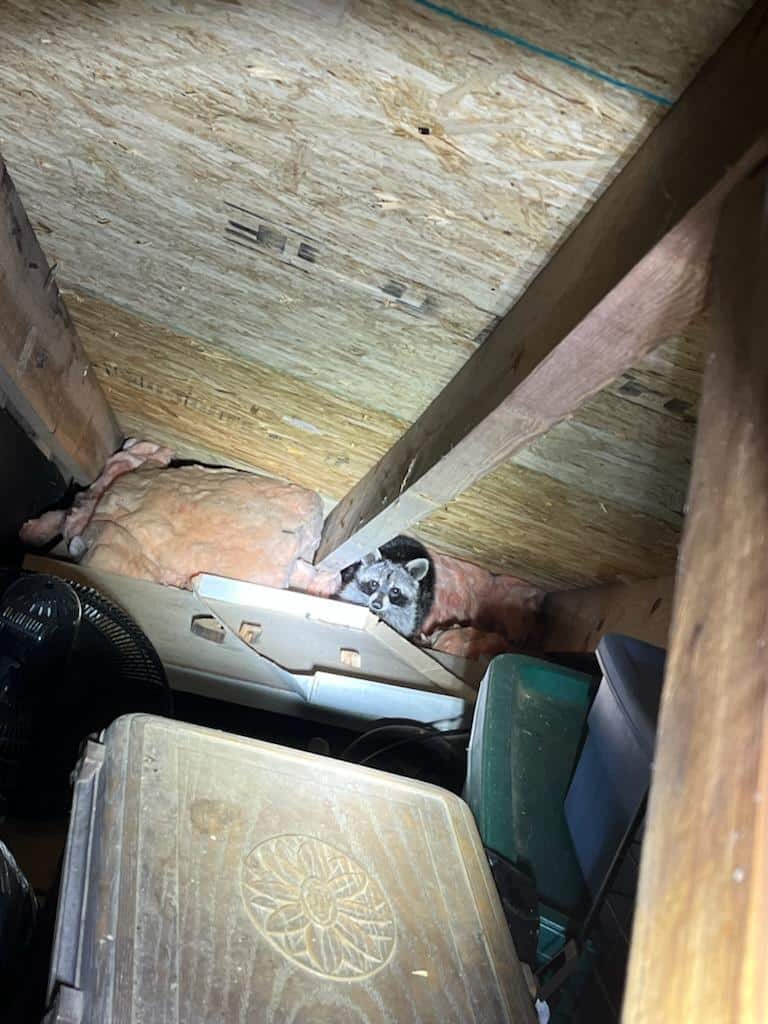
Need Help with Raccoon Infestation?
Find a Critter Control near you.
Have you been hearing scratching or other loud noises coming from above in your home? Then you may have raccoons in your attic! As it becomes more common for wildlife and human habitats to overlap in suburban and rural areas, raccoons have often been caught living in attics. This is especially true during breeding season when a female may take advantage of the warmth and safety from predators to give birth and raise her young.
Raccoons are not delicate animals. In your attic, you’ll hear thumping and scurrying sounds. Unfortunately, raccoons create costly damage. Professional raccoon-in-attic removal services should be enlisted to minimize the damage and protect your family from disease and parasites. Critter Control experts can safely and humanely remove the raccoon from your home.
Signs of a Raccoon in the Attic
Raccoons in the attic are one of Critter Control’s most common calls. Because they are fairly large animals, signs of raccoons in the attic can be easy to spot. Because of their size and weight, the sound of them lumbering around your attic is most likely the first sign you’ll experience. How many of the following raccoon signs you can spot will help determine whether their presence is fairly new or if they have a well-established nest:
- Noise – Raccoons are vocal animals, so you will not only hear them moving about, but you’ll also experience their growls, barks, and grunts. Baby raccoons, called kits, will make a chattering sound that resembles birds chirping.
- Roof Damage – Take a good look at your roof, soffits, or fascia for signs of holes and tears. Raccoons are quite strong, and it is easy for them to rip a hole through a weakened area when they are determined to get inside.
- Foul Smell – Raccoons build a latrine area away from their nest, so it will start to build up in an area, creating a foul odor. It can also leave stains on your ceiling if the build-up becomes large enough. In addition to fecal smells, you might also be experiencing the smell of rotting food brought in from the outside.
- Exterior Damage – When a raccoon is in your attic, likely, it is likely not wandering far off in search of food and water. Be on the lookout for damaged trash cans and bird feeders or a dug-up garden with eaten vegetables.
- Insulation Trails – Raccoons like to travel through a regular pathway, and if they need to walk through insulation, the insulation will be pushed to the side or compressed by their travels.
- Nesting Materials – Raccoons will bring twigs and leaves into the attic for their nests and also tear your insulation and any cardboard boxes or cloth you may have stored in the attic.
- Footprints – You’ll begin to see footprints in the yard, on your driveway, and in the snow if it’s winter.

The good news is that once you’ve discovered these critters, your call to Critter Control means a solution is close at hand. Critter Control arrives quickly to assess the infestation and put together a plan for the humane evacuation of the raccoons and their kits.
What Do Raccoons in Attics Sound Like?
Raccoons are the largest of the potential wildlife that can occupy your attic. So it stands to reason that raccoons in the attic sounds are loud. The noises they make will be a cross between their natural vocalizations and the sound of them jumping from place to place and shoving things around.
Raccoons are very vocal. You’ll hear grunts, growls, hisses, and snarls. When there are kits involved, you’ll also hear them squeaking and chittering.
How and Why Do Raccoons Get Into the Attic?
Raccoons are strong and dexterous animals, able to easily climb onto a roof via tree limbs, downspouts, and siding to get onto your roof. Then, they use their agile hands to tear open an entry hole. Common entry points include roof gaps, chimneys, damaged vents, broken attic windows, and loose soffits. One common sign of raccoons in your attic is a substantial hole found in your roof.
They are looking for a safe and warm place to live, give birth, and raise their young that is near a consistent food source. Raccoons are omnivores and opportunistic eaters. They’ve learned to thrive living amongst people, eating and feeding their kits from gardens and trash cans.
How Much Damage Can a Raccoon Do in an Attic?
Raccoons cause considerable and costly damage in your attic during the process of building their den and creating a latrine site. In addition to dragging in leaves and twigs, they will tear up insulation and cardboard boxes and use materials stored in your attic, such as blankets or clothing.
Other damage can include:
- Water damage is caused by rain and snow getting into your attic from the hole created to gain access to your attic.
- An unsanitary mess caused by their urine and feces. This produces not only a foul smell and damaged drywall but also health risks from parasites such as raccoon roundworm and leptospirosis.
- Damaged beams and electrical wires from their gnawing.
Are Raccoons in Attics Dangerous?
Raccoons in your attic are dangerous predominantly because they carry diseases and parasites that can be transmitted to people and pets. They are common carriers of rabies, leptospirosis, salmonella, and parasites, including roundworm and giardia.
Raccoon-in-attic removal is imperative to protect the health of everyone living in the house. Getting rid of raccoons on your own has its dangers, as they can become quite aggressive when threatened.
How to Get Rid of Raccoons in Your Attic
Raccoons should only be removed by a professional. It is not recommended to risk contracting parasites or getting bitten when trying to complete a DIY raccoon-in-attic removal plan. There are other considerations as well. There are laws regulating the removal, relocation, and harm of raccoons and their kits. Only a professional wildlife service such as Critter Control will know how to get rid of raccoons in your attic safely, humanely, and legally.
Raccoon Eviction Fluid
Raccoon eviction fluid is a repellent containing strong smells or ingredients that raccoons dislike to encourage them to leave on their own. This solution has limited success because the raccoons become used to the smell, especially if they have a well-established nest in your attic. Many of these fluids use ammonia, which could be a hazard not only to the raccoons but to the human house residents and pets.
Raccoon Deterrents
Other types of deterrents also include strong smells such as mothballs, cayenne pepper, and predator urine. Again, these are unreliable because raccoons become accustomed to the smell, and the smell also wears off. Deterrents such as motion-activated lights or sprinklers also provide limited results. Raccoons are quite smart. They will hang around long enough to figure out that no predator is lurking and the lights are harmless.
Habitat Modification
Habitat modifications work best both before and after having a raccoon in your attic. Modifications that include tightly sealed trash cans, a fenced-in garden, and keeping branches near your roof trimmed help to make your home less attractive to raccoons. They are not going to get a raccoon to voluntarily move out. Critter Control will not only provide you with a plan for raccoon removal but will also be able to point out where your property is vulnerable, so you can rectify it.
Raccoon Trapping
Raccoon trapping should only be done by a professional, as a trapped raccoon is angry and dangerous. Many localities prohibit relocating raccoons, too. Also, there is no way to know if the raccoon has recently given birth. If there are kits in the attic, consideration should be given to what happens to them once the mother is trapped and removed.
Critter Control has over 40 years of experience humanely trapping raccoons and legally relocating them, and, when kits are involved, Critter Control enlists the help of wildlife rehabilitation centers.
What to Do if a Raccoon Is in Your Attic
When you believe you have a raccoon in your attic, call Critter Control as soon as possible so you can limit your risk of damage to your home and health. Critter Control specializes in raccoon-in attic removal. They will send out a specialist who will conduct an inspection and provide you with a plan for removal, exclusion, and repair. Once the raccoons are gone, they will seal entry points and other places where your roof is vulnerable, and they will clean and sanitize the infested area.
If you have been hearing loud sounds coming from your attic and think you may have raccoons in the attic, Critter Control can help. Contact Critter Control for professional services to remove raccoons from your attic today at 1-800-CRITTER.
Attic Remediation after Raccoon Infestation
After a raccoon infestation, attic remediation is a must. This step restores your attic to a safe and clean condition, removing all traces of the raccoons’ presence.
Clean Up
Raccoon infestations leave behind contaminated materials that must be carefully removed.
Our cleanup process includes:
- Safely disposing of nesting materials and raccoon droppings.
- Using specialized sanitation agents, such as industrial-grade disinfectants, to disinfect the area.
- Eliminating harmful bacteria and odors to make your attic a safe environment once more.
Remove and Replace Insulation
Your uninvited attic guests may damage insulation during their stay, nesting in it and contaminating it with urine and droppings. During our inspection, we’ll evaluate the insulation and replace it if necessary. Generally, we recommend insulation replacement when:
- Areas are heavily contaminated with rodent waste.
- Insulation has suffered significant water damage.
- Insulation is old and no longer effective.
- There are signs of mold or mildew growth.
We can help prepare insurance bids for insulation replacement to ensure a seamless transition. We work with most major insurance companies to ease the financial burden.
TAP Pest Control Insulation
As part of the remediation process, we offer Thermal Acoustical Pest (TAP) Control Insulation. This is a specialized insulation that offers multiple advantages over run-of-the-mill insulation, including:
- Pest resistance: TAP insulation is infused with boric acid, which deters insects and other pests.
- Energy efficiency: It helps with temperature regulation, adding a layer of insulating protection that reduces heating and cooling costs.
- Noise reduction: TAP insulation offers superior soundproofing compared to traditional insulation, helping keep your home quieter and more comfortable.
We install TAP insulation to provide long-term protection against future infestations while improving energy efficiency and reducing noise.
Photos of Raccoons in Attics from Critter Control Offices






Watch Raccoon in Attic from Critter Control in Miami
Video courtesy of Critter Control in Miami
Get them out.
Keep them out.®
Experiencing a wildlife or pest issue? We can help! Complete this form and your local Critter Control® office will contact you to assist.
- How to Get Rid of Raccoons
- Are Raccoons Dangerous?
- Raccoon Trapping Service
- Raccoon Control
- Baby Raccoons
- Dead Raccoon Removal
- Raccoon Diseases
- Do Raccoons Hibernate in Winter?
- Raccoon Damage
- Raccoon Diet
- Raccoon Poop
- Raccoons In Yards
- Raccoons in Basements
- Raccoons in Chimneys
- Raccoons in Crawl Spaces
- Raccoons in Houses
- Raccoons in Trash
- Raccoons in Trees
- Raccoons in Walls
- Raccoons on Roofs & in Soffits
- Raccoon Sounds
- Raccoon Tracks
- What Does a Raccoon Look Like?